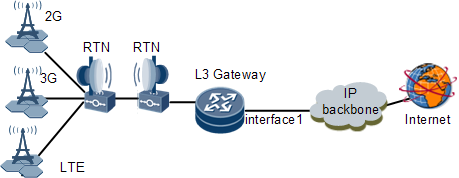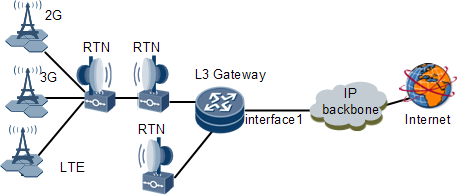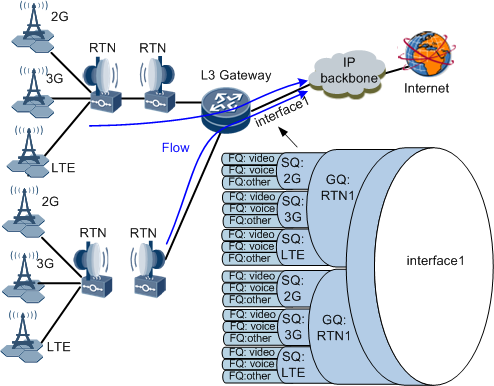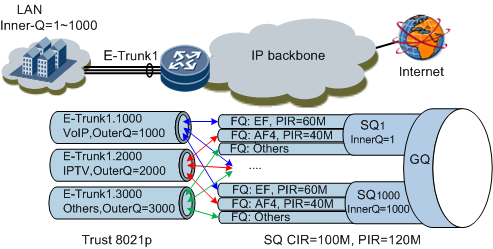Application Scenarios for HQoS
Use the following HQoS applications as examples:
- No QoS configuration: If QoS is not configured on an outbound interface and the default configuration is used, the scheduling path is 1 port queue -> 1 VI queue -> 1 GQ -> 1 SQ -> 1 FQ. Only one queue is scheduled at each layer. Therefore, the scheduling path can be considered an FIFO queue.
- Distinguishing only service priorities: If an outbound interface is configured only to distinguish service priorities, the scheduling path is 1 port queue -> 1 VI queue -> 1 GQ -> 1 SQ -> 8 FQs. Therefore, the scheduling path can be considered port->FQ.
Distinguishing service priorities + users: As shown in the following figure, an L3 gateway is connected to an RTN that has three base stations attached. To distinguish the three base stations on GE 0/1/8 of the L3 gateway and services of different priorities from the three base stations, configure the hierarchy architecture as port -> base station -> base station service, corresponding to the scheduling path: port -> 1 VI queue -> 1 GQ -> 3 SQs -> 8 FQs.

Interface 1 stand for GE 0/1/8.

Distinguishing priorities + users + aggregation devices: As shown in the following figure, an L3 gateway is connected to two RTNs (aggregation devices) that each has three base stations attached. To distinguish the two RTNs on GE 0/1/8 of the L3 gateway, three base stations on each RTN, and services of different priorities on the three base stations, configure the hierarchy architecture as port -> RTN -> base station -> base station services, corresponding to the scheduling path: 1 port -> 1 VI queue -> 2 GQs -> 3 SQs -> 8 FQs.

Interface 1 stand for GE 0/1/8.

HQoS is configured by Qos profile.
Class-based HQoS
Class-based HQoS uses multi-field (MF) classification to classify packets that require HQoS scheduling and treats all packets that match the classification rule as a user.
An SQ is configured in the traffic behavior view, then a traffic policy that defines the traffic behavior is applied to an interface.
Class-based HQoS takes effect only for upstream queues.
As shown in Figure 1, two interfaces on a router connect to RTNs, and each RTN has three base stations attached, each of which runs services of different priorities. The router, as an L3 gateway, is required to distinguish the three base stations and services of different priorities on the three base stations.
You can configure class-based HQoS to meet the preceding requirements. An interface has two user groups (two RTNs), one user group has three users (three base stations), and one base station runs multiple services. The hierarchical architecture is configured as port -> RTN -> base station -> base station services, corresponding to the scheduling path: port -> GQ -> SQ ->FQ.
Profile-based HQoS
Traffic that enters different interfaces can be scheduled in an SQ.
Profile-based HQoS implements QoS scheduling management for access users by defining various QoS profiles and applying the QoS profiles to interfaces. A QoS profile is a set of QoS parameters (such as the queue bandwidth and flow queues) for a specific user queue.
Profile-based HQoS supports upstream and downstream scheduling.
As shown in Figure 2, the router, as an edge device on an ISP network, accesses a local area network (LAN) through E-Trunk 1. The LAN houses 1000 users that have VoIP, IPTV, and common Internet services. Eth-Trunk 1.1000 accesses VoIP services; Eth-Trunk 1.2000 accesses IPTV services; Eth-Trunk 1.3000 accesses other services. The 802.1p value in the outer VLAN tag is used to identify the service type (802.1p value 5 for VoIP services and 802.1p value 4 for IPTV services). The VID that ranges from 1 to 1000 in the inner VLAN tag identifies the user. The VIDs of Eth-Trunk 1.1000 and Eth-Trunk 1.2000 are respectively 1000 and 2000. It is required that the sum bandwidth of each user be restricted to 120 Mbit/s, the CIR be 100 Mbit/s, and the bandwidth allocated to VoIP and IPTV services of each user are respectively 60 Mbit/s and 40 Mbit/s. Other services are not provided with any bandwidth guarantee.
You can configure profile-based HQoS to meet the preceding requirements. Only traffic with the same inner VLAN ID enters the same SQ. Therefore, 1000 SQs are created. Traffic with the same inner VLAN ID but different outer VLAN IDs enter different FQs in the same SQ.
HQoS Implementation on a Low-speed Links Interface
Interface-based HQoS allows an interface to function as a user. It means that all packets on an interface belong to an SQ.
Interface-based HQoS supports upstream and downstream scheduling.
HQoS Scheduling for Common Users
HQoS for common users identifies services by priority and then performs uniform scheduling.
HQoS Scheduling for Family Users
A family may use multiple terminals to demand various services, such as VoIP, IPTV, and HSI. These services have different requirements for delay, jitter, and bandwidth. In addition, requirements of high-priority services must be satisfied preferentially when network resources are insufficient. QoS scheduling must be performed based on a family rather than on each separate terminal.

